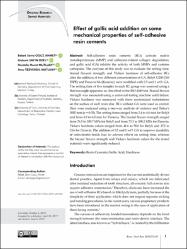| dc.contributor.author | Oğuz Ahmet, Bebek Serra | |
| dc.contributor.author | Sayın Özel, Gülsüm | |
| dc.contributor.author | Mutluay, Mustafa Murat | |
| dc.contributor.author | Tezvergil-Mutluay, Arzu | |
| dc.date.accessioned | 2019-12-23T14:25:22Z | |
| dc.date.available | 2019-12-23T14:25:22Z | |
| dc.date.issued | 2019 | en_US |
| dc.identifier.citation | Oğuz Ahmet, B. S., Sayın Özel, G., Mutluay, M. M. ve Tezvergil-Mutluay, A. (2019). Effect of gallic acid addition on some mechanical properties of self-adhesive resin cements. Brazilian Oral Research, 33. https://doi.org/10.1590/1807-3107bor-2019.vol33.0053 | en_US |
| dc.identifier.issn | 1806-8324 | |
| dc.identifier.issn | 1807-3107 | |
| dc.identifier.uri | https://doi.org/10.1590/1807-3107bor-2019.vol33.0053 | |
| dc.identifier.uri | https://hdl.handle.net/20.500.12511/4625 | |
| dc.description.abstract | Self-adhesive resin cements (RCs) activate matrix metalloproteinase (MMP) and cathepsin-related collagen degradation, and gallic acid (GA) inhibits the activity of both MMPs and cysteine cathepsins. The purpose of this study was to evaluate the setting time, biaxial flexural strength, and Vickers hardness of self-adhesive RCs after the addition of two different concentrations of GA. RelyX U200 (3M ESPE) and Panavia SA (Kuraray) were modified with 0.5 and 1 wt% GA. The setting time of five samples in each RC group was assessed using a thermocouple apparatus as described in the ISO 4049 test. Biaxial flexure strength was measured using a universal testing machine until failure. Vickers hardness was measured with three randomized indentations on the surface of each resin disc. RCs without GA were used as control. Data were analyzed using a one-way analysis of variance and Tukey's HSD test (α = 0.05). The setting times ranged from 2.4 to 4.6 min for RelyX and from 4.9 to 6.0 min for Panavia. The biaxial flexure strength ranged from 76.5 to 109.7 MPa for RelyX and from 73.3 to 108.2 MPa for Panavia. Vickers hardness values ranged from 41.6 to 58.6 for RelyX and 27.2 to 33.6 for Panavia. The addition of 0.5 and 1 wt% GA to improve durability of resin-dentin bonds had no adverse effects on setting time, whereas the biaxial flexure strength and Vickers hardness values for the tested materials were significantly reduced. | en_US |
| dc.language.iso | eng | en_US |
| dc.publisher | NLM (Medline) | en_US |
| dc.rights | info:eu-repo/semantics/openAccess | en_US |
| dc.rights | Attribution 4.0 International | * |
| dc.rights.uri | https://creativecommons.org/licenses/by/4.0/ | * |
| dc.subject | Resin Cements | en_US |
| dc.subject | Gallic Acid | en_US |
| dc.subject | Hardness | en_US |
| dc.title | Effect of gallic acid addition on some mechanical properties of self-adhesive resin cements | en_US |
| dc.type | article | en_US |
| dc.relation.ispartof | Brazilian Oral Research | en_US |
| dc.department | İstanbul Medipol Üniversitesi, Diş Hekimliği Fakültesi, Protetik Diş Tedavisi Ana Bilim Dalı | en_US |
| dc.authorid | 0000-0002-1387-2989 | en_US |
| dc.authorid | 0000-0001-8833-5259 | en_US |
| dc.identifier.volume | 33 | en_US |
| dc.relation.publicationcategory | Makale - Uluslararası Hakemli Dergi - Kurum Öğretim Elemanı | en_US |
| dc.identifier.doi | 10.1590/1807-3107bor-2019.vol33.0053 | en_US |



















